Test drive: 2022 Ford F-150 Lightning
The 2022 Ford F-150 Lightning is Ford’s first electric truck and has features not found on any other F-Series model. Fox News Autos Editor Gary Gastelu takes it for a spin.
NEWYou can now listen to Fox News articles!
At the first test drive event for the new Ford F-150 Lightning, some of the engineers who built the electric pickup were wearing shirts with a Model T logo on it.
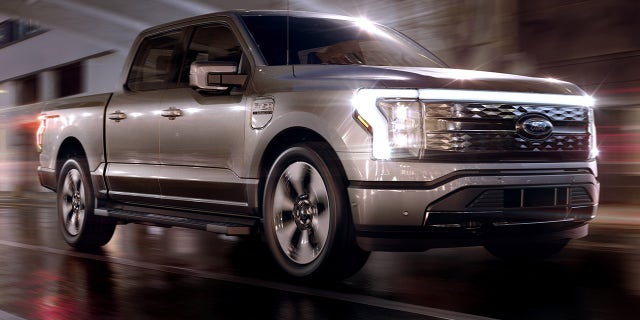
2022 Ford F-150 Lightning Platinum is the top of the line trim.
(Ford)
It was a reference to Ford’s milestone mass-market car, but with at 21st century twist. The T was borrowed from the Lightning’s logo and shaped like an electric bolt. The message was clear: This is big deal for Ford.
The automaker has been touting the Lightning as the most important vehicle it’s introduced since the Model T, and the parallels aren’t too much of a stretch. The F-Series long ago surpassed the Model T as both the brand’s and USA’s all-time best-selling model, so using it as the basis for an electric vehicle proves Ford means business.

The F-150 Lightning has a unique logo.
(Fox News Autos)
Ford expects to be building Lightnings at an annual rate of 150,000 by the middle of next year, which would represent around a fifth of F-Series sales, and is working on a next-generation pickup that will be produced at even higher volumes. Assuming people want them.
Signs are that they very much do. Customers have placed over 200,000 reservations for the Lightning already, but few of them have even seen it in person let alone driven one, so they don’t really know what they’re getting into.
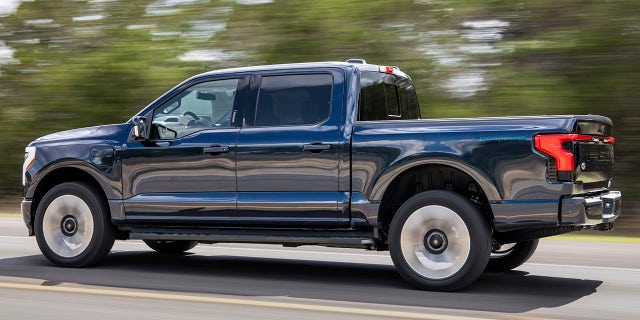
The F-150 Lightning shares its body with other F-150s.
(Ford)
The first thing you notice about the Lightning is that you don’t really notice it. It uses the same aluminum body and cab as the rest of the F-150 lineup, with tweaks to the lights and grille, the latter of which is now phony because the electric drivetrain doesn’t need it for cooling. It turns the occasional head on the road, but doesn’t get swarmed like some new vehicles do.
The parts sharing helped Ford beat the competition to market by a year, leverage the existing F-150 repair network and reduce development and production costs.
The Lightning starts at a shockingly low $41,669, which is cheaper than the Ford Mustang Mach-E electric SUV. That’s before you subtract any of the incentives it currently qualifies for, including a $7,500 federal tax credit that brings the bottom line down to $34,169, delivery and other purchase fees included.
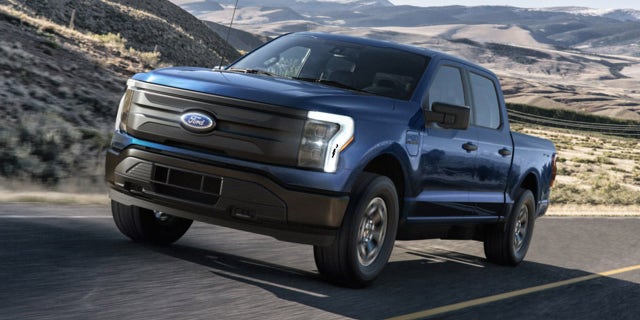
2022 Ford F-150 Lightning Pro is the entry level model and starts at $41,669.
(Ford)
The entry level Lightning is the work-oriented Pro that comes with a four-door SuperCrew crew cab body and a two-motor all-wheel-drives system rated at 452 horsepower and 775 lb-ft of torque. For comparison, the cheapest F-150 XL 4×4 SuperCrew with a gas engine has a base price of $44,220, 325 hp and 400 lb-ft.
The Lightning Pro’s EPA-rated range is just 230 miles between charges, however, and if you want more it’s going to cost a lot more. It requires a step to the $54,769 XLT trim and an optional extended range battery pack good for 320 miles that brings the price to $74,269. Higher end Lariat and Platinum trims are also available, with top models going for over $93,000.
8 TIMES FORD REINVENTED THE F-SERIES PICKUP
As a bonus, the extended range trucks get 580 horsepower, making them the most-powerful F-150s, which boosts their tow ratings from 7,700 pounds to 10,000 pounds, while the maximum payload drops from 2,250 pounds to 1,800 pounds, due to the increased battery weight.
Regardless of the model, the Lightning is built on a frame that differs greatly from those under the internal combustion engine trucks and features the first independent rear suspension ever used on an F-150. The battery is secured within the rails using just eight bolts to make it easy to remove for service, if needed.

The Mega Power Frunk is standard on all F-150 Lightnings.
(Ford)
The Lightning’s signature feature is a front trunk under a power-opening hood where the engine used to be. Not every electric vehicle has one of these, and the Lightning team needed to move equipment out of the way to create a 14 cubic-foot waterproof space that can carry up to 400 pounds. It should be equally appreciated by grocery shoppers, golfers and contractors who don’t want to leave their gear unsecured in the bed.

2022 Ford F-150 Lightning Pro features a commercial-grade vinyl interior.
(Ford)
Before I get to how the Lightning drives, it’s important to note what it can do when it’s not moving. All models can double as generators at power outputs ranging from 2.4 kw to 9.6 kw, with up to ten 120-volt outlets located throughout the truck plus one 240-volt outlet for good measure. Since there are no emissions, it can be used for this purpose indoors.
Along with the ability to power electrical equipment at job sites, campsites and tailgate parties, the Lightning also offers a bidirectional capability that meshes with a $3,895 home integration system to allow it to power a typical home for three days with the extended range battery pack before you even start turning things off to conserve electricity.
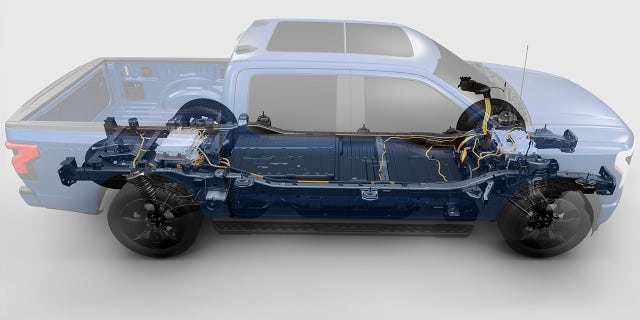
The F-150 Lightning’s battery pack can be used to power electrical equipment.
(Ford)
When the power grid is working, the system can be used for arbitrage, where the battery charges with cheap off-peak electricity and then uses it to power the home when rates rise. An app lets you set a limit on how far the battery will drain during this process so you don’t run it all the way down and make the truck useless as a truck. And the Lightning is far from useless as a truck.
A couple of minutes is all it takes to realize this is a better F-150. The power comes on seamlessly and strong, and the ride quality provided by the fully independent suspension is superior to any full size pickup’s … except for the $112,495 GMC Hummer EV, which also has one, but is a high performance off-road monster that weighs approximately a ton more than the Lightning and targets a different market.
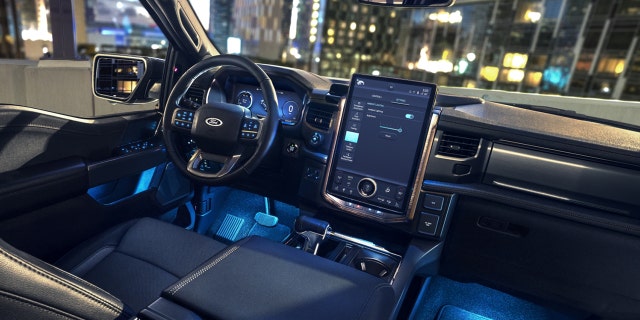
F-150 Lightning Lariat and Platinum trims get a 15.5 inch digital display.
(Ford)
Even as you rocket it to 60 mph in about four seconds like it’s a sports car, the Lightning is nearly silent. That is unless you turn on the synthetic digital motor noise it can pump into the cabin to amp up the excitement, which is an unconvincing substitute for the real thing.
The only time the Lightning feels odd for a full size pickup is when you slam the accelerator, especially in a turn, and it chirps the front tires and tugs the steering wheel in your hands like an old front-wheel-drive hot hatchback. The front motor is just as powerful as the rear one and the Lightning can’t always handle that truth.
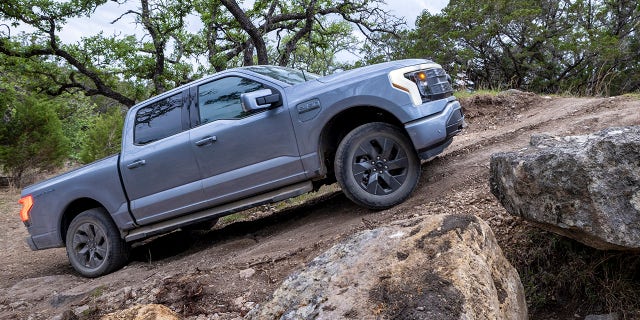
The F-150 Lightning has a locking rear differential.
(Ford)
The Lightning isn’t available in a specific off-road version and only has 8.9 inches of ground clearance, but all trims come standard with underbody protection for the battery and an electronic locking rear differential for optimal traction on slippery surfaces and tough terrain. The suspension is just as impressive off-pavement as it is on the highway and the Lightning has no trouble scurrying up moderately steep rocky climbs. You could ride fences in it all day long without being worse for wear.
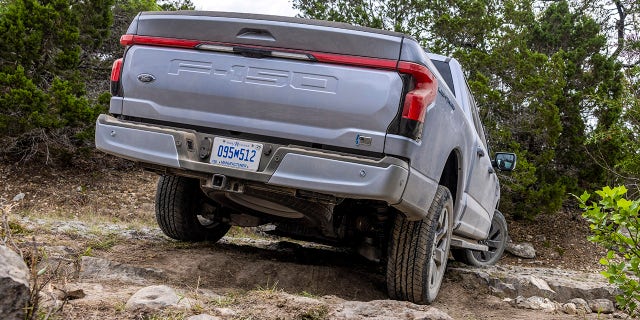
The F-150 Lightning is the first F-Series truck with an independent rear suspension.
(Ford)
Back on the road, the various Lightnings I tried over a couple of hundred miles delivered range and energy economy close to their official ratings, which works out to the equivalent of 66-70 mpg. That makes them the most efficient full size trucks ever built by a wide margin.
But what about when they’re hauling or towing something? According to Ford, the drop in efficiency is essentially the same as it is for an internal combustion engine truck. Without a back-to-back comparison, I can’t vouch for that, but I can tell you that pulling a 9,500-pound trailer is absolutely effortless. So much so that if you got into a Lightning with one hitched up, but didn’t know it, you might not realize it for a couple of miles.
CLICK HERE FOR MORE FOX NEWS CAR REVIEWS
But the Lightning does, and can improve its towing performance over time as it learns the different trailers you use, the roads you drive on them with and adjusts the drivetrain accordingly. Ford is even pulling anonymous data from the Lightning fleet and creating a library that each one can draw from when it approaches an unfamiliar road with a trailer of a certain weight.

The F-150 Lightning has a maximum towing capacity of 10,000 pounds.
(Ford)
Charging at a public station with a trailer may pose a challenge, as they aren’t often oriented for a vehicle with something in tow, so you might need to remove it to pull up to the plug. The charge port’s location on the left front fender does allow you to park head-in if there’s room behind you to leave the trailer sticking out. The optional 360-degree camera and self-steering Pro Trailer Backup assist can come in handy in this situation.
If it’s a DC fast charging station, the battery can be refilled to 80 percent in just over 40 minutes. Charging it all the way will take half a day on a 240-volt charger, either on the road or at home. Gas stations were few and far between when the Model T was introduced and the national electric car charging network similarly has a way to go, but having the ability to charge this newfangled contraption in your garage is the real boon.
CLICK HERE FOR TO GET THE FOX NEWS APP
Ford is hopeful that the Lightning will be the vehicle that’s convincing enough to get the bulk of Americans who aren’t already on the Tesla bandwagon over the hump of electric vehicle ownership, the way the Model T got them off horses. Early adopters should be happy they came along for the ride, and the Lightning has what it takes to win over more than a few fence-sitters. As for the rest, Ford isn’t entirely giving up on internal combustion engines just yet, but if it can bring the price of more Lighting trims down and increase their range a little more, it may be able to soon.
———-
2022 Ford F-150 Lightning
Base price: $41,699 to $93,703
Type: 4-door, 5-passenger all-wheel-drive pickup
Motor: Dual-motor electric
Power: 452-580 hp, 775 lb-ft torque
Transmission: single-speed automatic
MPGe: 66-70 combined
Range: 230-320 miles


























































